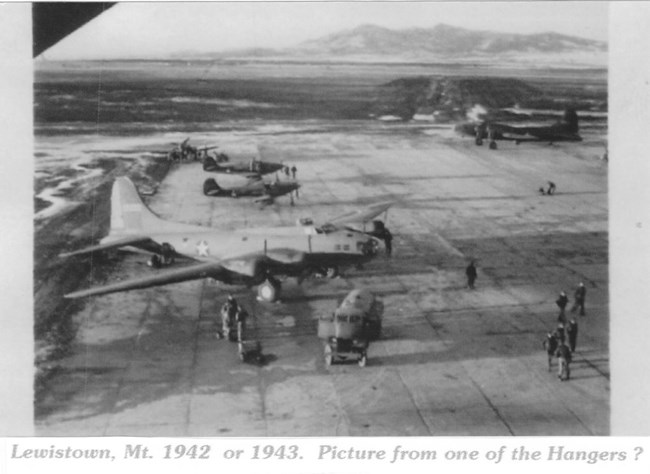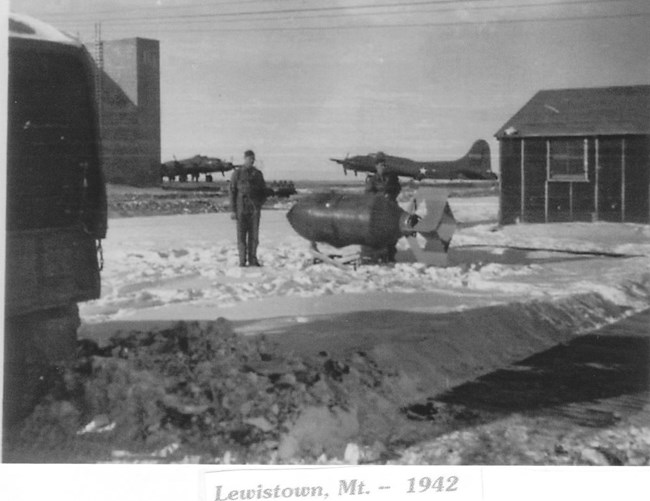Part of a series of articles titled Lewistown, Montana, WWII Heritage City Lessons.
Article
(H)our History Lesson: Lewistown Army Airfield and B-17 Flying Fortresses in Lewistown, Montana, World War II Heritage City

Lewistown Public Library; Central Montana Historical Photographs
About this Lesson
This lesson is part of a series teaching about the World War II home front, with Lewistown, Montana designated as an American World War II Heritage City. The lesson contains readings and photos to contribute to learners’ understandings about the Lewistown Satellite Airfield Historic District. Service members were relocated to Lewistown to train as B-17 Flying Fortress crews, and with the top secret Norden bombsight.
Objectives:
- Explain the connections among the B-17 Flying Fortresses, the Norden bombsight, and training at Lewistown Army Airfield.
- Describe the factors contributing to the success of the bombers in raids during World War II with connections to Lewistown.
- Compare local, historical perspectives on service to synthesize and connect to larger wartime perspectives and themes.
Materials for Students:
- Photos (can be displayed digitally)
- Readings 1, 2, 3 (and optional extension)
- Recommended: Map of Montana with Lewistown marked; other airfields can also be marked.
Getting Started: Essential Question
How did the Lewistown Army Airfield lead to the success of bombing raids during World War II?
Reading to Connect
“Lewistown Army Airfield, 1942-1943"
Erected by Montana Department of Transportation in Fergus County, Montana
“At this airfield, US Army Air Force airmen trained to fly and fight with the Boeing B-17 Flying Fortress during the darkest days of WWII. Heavy bomber crews completed final proficiency phase training here before being assigned to aerial combat in Europe and North Africa. The combat squadrons polished the vitally important skills of formation flying, precision bombing with the top secret Norden bombsight, aerial gunnery and navigation.
The Montana airbases were constructed in record time by the US Army Corps of Engineers. By the first anniversary of the Pearl Harbor attack, B-17 aircraft were landing at this airfield. The 49th, 548th, 570th, and 615th Bomb Squadrons all preformed crucial Organizational Training Unit missions in Montana. B-17 training bases were also located at Cut Bank, Glasgow, and Great Falls.
"The Montana-trained squadrons flew a total of 1263 combat missions, dropped 71,128 tons of bombs, lost 548 aircraft and shot down 1018 enemy planes without ever turning away from a mission. They earned Presidential Unit Citations for valor and fortitude over Leipzig, Oscherslaben, Regensberg, Schweinfurt, Steyr and Zwickau. Assigned to the Mighty 8th and 15th Air Forces, the unwavering courage and unbowed bravery of airmen from this Montana airfield shines as this nation's bright pride.”
[Note: The following are the countries for each city: Leipzig, Oscherslaben, Schweinfurt, Zwickau (Germany); Regensberg (Switzerland); Steyr (Austria).]
Proving Their Worth
Lewistown Democrat-News, September 9, 1942, p. 4
Our huge American Flying Fortresses have made a dozen raids over enemy territory from their bases in Britain with the loss of but two of their number. These big bombers have made all their raids in daylight, which exposes them to greater hazards from enemy fighter planes than are faced by night bombers. Before they went into action, it was predicted that our fortresses would be easy prey of fast fighter craft, but these dire predictions have not been fulfilled.
These big fellows have shown that they can not only fly to and effectively bomb their objectives from stratospheric heights, but can also successfully fight off swarms of the best fighters the enemy can send against them. Their heavy armor enables them to take a lot of punishment, and their eight gunners have shown an ability to shoot down any planes that come within range of their weapons. The precision with which Fortress bombardiers land their deadly loads on targets from heights of from fifteen to twenty thousand feet has been a source of amazement to allies and enemies alike. This success is doubtless due in large part to their use of the Norden bombsight, our most closely guarded war secret and one which any other major nation at war would give millions to possess.
Elmer Cheatham, B-17 Radio Operator
Background
Elmer Cheatham (1924 – 2015) was born in New Orleans, Louisiana. His family moved to Haleyville, Alabama in 1927. He graduated from Haleyville High School in 1942. Cheatham joined the U.S. Army on November 30, 1942 in Birmingham, Alabama. Cheatham trained in Lewistown, Montana, at the Lewistown Satellite Airfield and served overseas as a B-17 radio operator. Cheatham served for one enlistment until his Honorable Discharge on December 6, 1945 in Fort McPherson, Georgia, at the rank of Tech Sergeant. The following are recollections from his son, Mickey Cheatham, on his father’s service.
Elmer Cheatham’s Service
“My dad was from Alabama and trained in Lewistown. While there he dated a young lady, Constance June Blaine. She was my mom. Since my grandfather, Lee Blaine, my mom’s dad, had a grocery store, he had gas coupons for delivering groceries. So, my dad and mom dated in her father’s car. After the war he returned to Lewistown and married her. Our family lived in Lewistown from 1950 to 1967. My mom was third generation, and my brother and sister were born there as fourth generation Lewistown residents.
After training in Lewistown, my dad was a radioman on B-17s and did 30 missions. His location in the B-17 was just after the bomb bay and he had the radio and a gun in the top of the plane. Right behind him were the two waist gunners. They shot out a large open “window,” so it was very cold and windy. Everyone wore electric heated flight suits.
At one point the training was over and dad’s crew took off in their B-17 for England. When they landed to refuel, I think in Kansas, they received new orders. Apparently, there wasn’t room at the base for them and so they were ordered back to Lewistown for additional training. So, they returned.
One of the crewmen my dad trained with also dated a Lewistown girl. After returning from the lack of space in England, my dad’s friend married his girlfriend. But my dad told me at that time he didn’t think that marriage would last. I suppose because it was so rushed. (But after the war, that couple reunited and they remained married for over 50 years. Once, when visiting my dad out in Oregon, we visited with his wife. He had died a few years before that. So, the marriage did last.)
More about this other airman. He was a gunner in the belly “Ball Turret” of the B-17. That is a very precarious and claustrophobic job. So, after a few missions, he declined to fly anymore and asked to quit that job. To quote my dad, “That was really desertion, and they usually shoot you for that. But they didn’t and just reassigned him to another job.”
A little while later, there was a large mission by the group in England, and many planes were lost. So now there was space for my dad's crew at the base in England. They left Lewistown finally and entered the war. My dad kept in touch by letter with my mom during the entire war.
On my dad’s first mission in England, as they taxied to the runway in line with several other bombers, the brakes failed on my dad’s plane. The pilot tried to turn off the runway, but the plane collided with the plane in front taxiing. Both planes got some damage, and they didn’t fly that day. They did finally fly. They needed 25 missions to complete, but Jimmy Doolittle (I think) was the new commander and extended that goal to 30 missions. That didn’t make him very popular with the airmen. Since my dad was a Radio Operator and they were in short supply, he flew a few missions with other planes. So, he completed his 30 missions before the rest of the crew. He then returned to the US via boat. Later, his plane, “Stormy Weather” was shot down with the rest of his old crew. Some died and some bailed out and were rescued. . . There’s more to the story because my dad ended up going back overseas, this time to India where he flew the hump over the Himalayas.”

Lewistown Public Library; Central Montana Historical Photographs
By the numbers:
-
The B-17 airplane, called the “Flying Fortress,” had four engines and was used in World War II bombing campaigns. Nearly 1,000 service members trained at The Lewistown Satellite Airfield with B-17s.
-
For a comparison, the population of Lewistown, Montana in 1940 was 5,874.
Quotations to consider:
“Our flying fortress bombers produced magnificent results in the fighting in the East Indies. . . .Even greater satisfaction is derived from the knowledge that we have planes capable of carrying the war into enemy strongholds.” - “Will Do the Job,” Lewistown Evening Telegram, April 17, 1942, p.4
“My grandfather, a plumber in Lewistown, would paint a stripe on the side of their home each time a local serviceman shot down an enemy plane...the story has been told for decades.” - Jeanette Adam

Photo courtesy of Mickey Cheatham, son of Elmer Cheatham
Student Activities
Questions for Reading 1 and Photos
- Who built the Montana air bases, such as Lewistown’s Airfield?
- What was the purpose of the Lewistown Army Airfield? What abilities did service members gain during their time there?
- Why were the squadrons recognized for valor?
Questions for Reading 2
- What features made the B-17 Flying Fortresses successful in raids?
- Connect Reading 1 and 2: How did the Lewistown Satellite Airfield connect to the success of the bombardiers in the raids, and the use of the Norden bombsight?
- How do you think the success of the American Flying Fortresses during World War II impacted both the morale of the home front in Lewistown, and the Allied forces overseas?
Questions for Reading 3
- Who was Elmer Cheatham and what were his contributions as a service member in World War II?
- How did Elmer Cheatham's training in Lewistown, Montana, contribute to his service during World War II?
- What were challenges Cheatham’s crew faced?
- What benefits and challenges are associated with exploring narratives told by family members to understand life on the home front and the experiences of service members during World War II?
Lesson Closing:
How did the Lewistown Army Airfield lead to the success of bombing raids during World War II?
Extension Activities
The only identifiable Norden bombsight building still standing in the United States is part of the Lewistown Satellite Airfield Historic District.
Learn more about the top secret Norden Bombsight and its importance:
Lewistown had many local enlistments and those who served in the war. This reading shows one example:
Quartet of Local WAACs Leave Monday
The Sunday Democrat News, January 31, 1943
The Misses Helen Hagstrom, Marimavis Evans, Virginia Alm and Enid Mason Head for Fort Des Moines, Iowa, Monday Nite.
Four Fergus County young women who have recently enlisted in the woman’s army auxiliary corps have received their call and will leave Monday night for the WAAC training headquarters at Fort Des Moines, Iowa.
They are Helen Hagstrom, Marimavis Evans and Virgina Alm, all of Lewistown, and Enid Mason of Denton.
Although definite plans have not been announced, it is understood members of the Elks band and others are preparing to give the local WAAC contingent a community farewell send off as they embark for their training assignment with the U.S. Army.
Research
Learn more about the WAACs and their importance. They became the Women's Army Corps (WACS) in August of the year this article was written.
This lesson was written by Sarah Nestor Lane, an educator and consultant with the Cultural Resources Office of Interpretation and Education, funded by the National Council on Public History's cooperative agreement with the National Park Service.
Tags
Last updated: September 18, 2024
